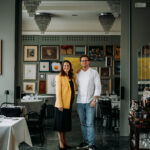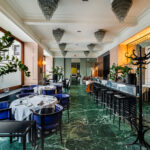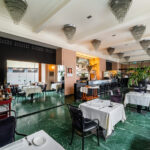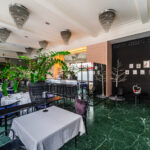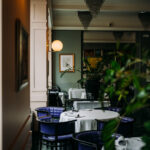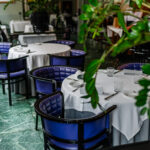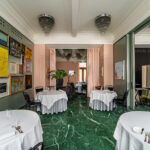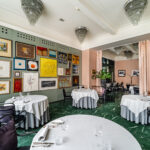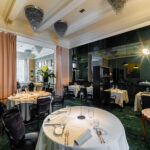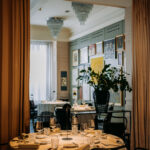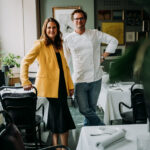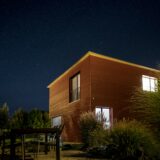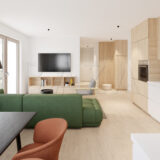The story of JB Restaurant is not just a culinary one – it’s a family legacy, generational, and deeply infused with respect for tradition. When Nina and Tomaž took over the management of the restaurant, founded more than thirty years ago by their father, the legendary chef Janez Bratovž, they inherited not just a name, but also a responsibility to the space, the people, and the spirit that surrounds them. In this conversation, they reveal how, with reverence for the past and a sense for the contemporary, they co-create a space where the story is never finished – only transitioning into a new chapter.
They talk about how they perceive their role, how they think about the space and its development, and why it is important that the past and future meet in balance – not in opposition.
How do you perceive the history of JB Restaurant and the role you’ve taken over from your father?
Our restaurant has a thirty-year story, successfully led by our parents. Now it’s our time, and we are very happy and extremely proud that everything is going well. The transition wasn’t easy; we’ve been involved in the story for years, not just now when we’ve taken over the business side. On one hand, it’s a great honor; on the other, a huge responsibility – to take over such an institution and lead it forward at least as well, if not better, than our parents did. There’s certainly a big challenge and a lot of work ahead.
How did you decide how much of your own vision to incorporate into the legacy? Have you renovated the space, or do you plan to?
Because our restaurant is part of a Plečnik building, we are limited when it comes to making changes, and at the same time, we’re very proud that this is part of our story and we wouldn’t want to change that. In terms of the interior, we absolutely wish to refresh certain things. Sooner or later, we will definitely make some changes, but that takes time, adjustments, and coordination of wishes.
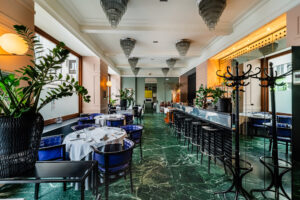
What kind of privilege is it to have a restaurant in a Plečnik building?
Having a restaurant in a Plečnik building is a very special privilege. It’s a powerful, architecturally significant building that you don’t notice every day – until you really stop and look at what stands before you. From the moment you enter, you’re captivated – you feel the weight of history and the uniqueness of the space. We do feel that some people might even be a bit intimidated by such grandeur. Maybe we’ve lost a few guests because the space feels so imposing, almost “too serious.” But at the same time, this uniqueness gives the restaurant a soul and a story that can’t be recreated anywhere else. It’s not just a backdrop – it’s a space with character that one must know how to listen to.
What would be your initial inspiration for a redesign or transformation of the interior, if you decided to pursue it?
We would like to bring a bit more youthfulness into the space, but since it’s still a very classic space, we would retain that concept as the main thread of the interior. We believe that with small details and carefully chosen pieces, we can refresh the space and enhance the culinary experience.
Is your design philosophy a reflection of a shared vision, or does each of you bring a unique touch?
Since this is a joint business, it’s crucial that we make decisions together. We know we don’t want a generic “bistro” like the ones that are currently proliferating – where there’s little distinction between them. We are known as a classic restaurant with a French touch, so at this point, we’d like to make the most of our large windows and go with a Parisian-inspired vibe. The whole renovation will require quite a bit of thought.
How important do you think the ambiance is in the modern culinary experience?
Hugely important. People who come to a restaurant want a full experience. They want to be somewhere they feel good, where the atmosphere is right. Since there’s so much innovation and change in food, it’s increasingly important that all elements align. We’re very aware of that, which is why we’re striving for changes.

Will you collaborate with architects or interior designers in planning the space?
Absolutely – we believe that collaboration with architects or interior designers is key when it comes to designing a space. It’s important that the person isn’t just an expert with knowledge, but also someone who knows how to listen and understand our vision. We believe the right approach is one where balance is found between the client’s ideas and the expert’s knowledge. When the client shares their desires, a good designer can shape them into a meaningful and aesthetic whole. The most important thing is that we align in our overall view. For us, the right collaborator is someone who can listen and co-create.
How often do you adapt the interior – seasonally or according to culinary concepts?
We adapt the interior thoughtfully; throughout the year, there are subtle changes. Seasons play an important role – we switch arrangements, select different flowers, maybe change up some details to create a fresh atmosphere. Sometimes changes stem from culinary concepts – when the menu gets a new story, we try to visually support it too. It’s not about complete transformations, but gentle shifts that bring new energy to the space while preserving its character. In the near future, we’re planning some larger changes, always with respect for the space and its core identity.
Which interior elements do you believe best reflect the spirit of the restaurant?
We believe it’s best reflected in authentic elements that carry the story of the space. The chairs we sit on are over 50 years old – we searched long and hard for them, and today they’re somewhat of a signature piece. Despite their age, they are of exceptional quality, stable, and aesthetically timeless – something rare today. The same goes for the original chandeliers and the green marble floor, which immediately catches the eye. It’s about respecting heritage and mindfully preserving what has value.
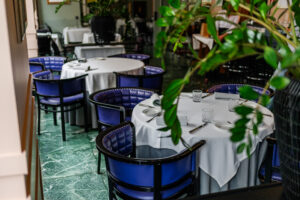
What role does lighting play in the space?
Lighting plays a very deliberate and distinct role in our space. In the evening, the room is lit exclusively by table lamps, without any additional light sources. Each table is lit intimately. This creates a special atmosphere: calm, soft, and almost theatrical – as if every conversation, every plate is center stage. Lighting is part of the culinary experience. You should come for dinner sometime.
Have you ever doubted yourselves: “Would our father like this?”
Honestly – our father was never the issue. If we ever doubted anything, it was more like: “What will Mom say?” (laughs). She has an incredible eye for detail – she’ll move a flower, shift an object, and constantly surprises us with how subtly she can improve a space. She’s the one we have the most “creative challenges” with, but she’s also often the one who adds that final perfect touch. So, if there’s ever a question, it’s not: “Would Dad like this?” but more: “Will Mom move it?”
What’s the story behind the striking wall of paintings?
The story of that wall started quite spontaneously. Initially, the paintings were distributed throughout the restaurant – it’s a large collection, some even painted by our father. When we undertook a renovation a while back, the architects suggested creating a distinct focal point – a wall that would serve as a strong visual element. Today, that wall has become a kind of visual signature of the restaurant. It connects art, personal story, and ambiance.
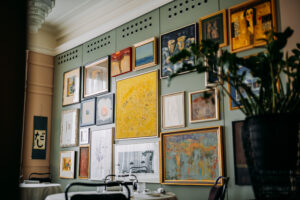
Are there any hidden symbols or tributes to your father in the interior?
There are two photographs of our father in the space, each with special symbolic value. The first was taken when he was 30 – when he opened the restaurant. When he turned 60 and decided to hand over the reins, we took him to the same photographer to recreate the exact same photo – from the same angle, just with 30 more years of experience. Today, both photos decorate the space. Together, they are a quiet tribute to our father and the history of the restaurant – and a beautiful symbol of continuity.
How do you want guests to feel when they enter your space?
We want guests to immediately feel welcomed – as if they’ve stepped into a place where everything is in its right place and where they can truly relax. Warmth, homeliness, and refined simplicity are the feelings we wish to create. Nothing is forced, nothing is overdone, but every detail has its purpose. The space should speak quietly but sincerely – so that the guest feels welcomed and knows they’ve arrived at a place where they can truly pause.

